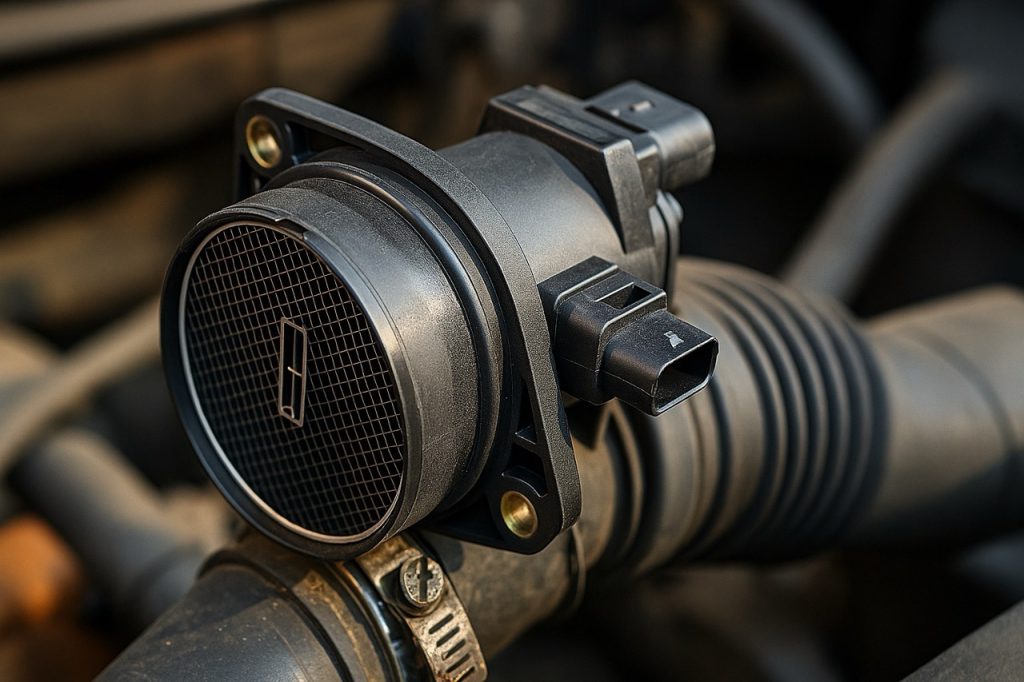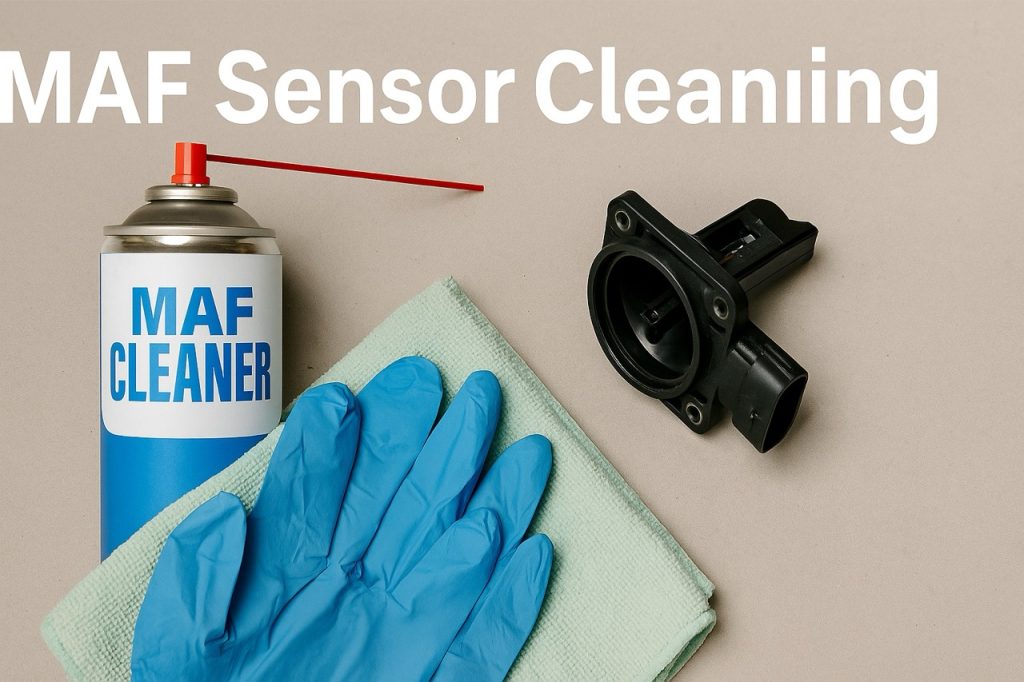Why Mass Air Flow Sensors Go Bad?
What Causes Mass Air Flow Sensor to Go Bad? The mass air flow sensor (MAF sensor) is one of the most important parts of your car’s fuel management system. Its job is to measure how much air enters the engine and send that information to the ECU (engine control unit). The ECU then calculates the exact amount of fuel needed to keep the engine running smoothly.
When the sensor is dirty or faulty, it sends incorrect readings. This can cause poor fuel economy, hesitation, stalling, or even long-term engine damage. That’s why understanding what causes mass air flow sensor to go bad is essential if you want to keep your vehicle reliable and avoid unnecessary repairs.
Table of Contents

Can a Mass Air Flow Sensor Go Bad?
Yes, a mass air flow sensor can Absolutely go bad. Like any electrical part, it can fail naturally over time. However, most failures are not from age alone. They are caused by:
- Contamination (dirt, dust, pollen, or oil buildup).
- Moisture damage.
- Faulty wiring or loose connectors.
- Incorrect cleaning methods.
So while a mass air flow sensor can go bad, it usually happens because of avoidable issues rather than the sensor simply “wearing out.”
What Causes Mass Air Flow Sensor to Fail?
Many drivers specifically ask: what causes mass air flow sensor to fail? Here are the most common culprits:
- Dirt and debris buildup: If the air filter isn’t replaced regularly, dust and contaminants slip past and coat the delicate wires inside the sensor.
- Oil contamination: Oiled filters (like some aftermarket K&N filters) release fine oil particles that stick to the sensor and disrupt readings.
- Moisture or condensation: Water can corrode or short the sensor’s electronics, especially in humid or rainy environments.
- Electrical issues: Damaged wiring, loose connectors, or corroded terminals cause incorrect signals to the ECU.
- Engine backfires: A rare but destructive event that can burn or break the thin sensor wires.
When these issues occur, the ECU can no longer calculate the correct air-fuel ratio, leading to rough performance or a check engine light.
What Causes Mass Air Flow Sensor Problems?
Sometimes, drivers don’t experience a complete failure but instead face irregular performance. This leads to the question: what causes mass air flow sensor problems?
Common issues include:
- Intermittent poor readings: Dirt or small amounts of oil can cause the sensor to misread airflow occasionally.
- Sensor drift: Over time, even light contamination causes the sensor to slowly read “off,” making the ECU adjust fuel incorrectly.
- Electrical noise: Weak wiring connections may cause unstable signals, leading to stalling or hesitation.
In short, even minor contamination or wiring issues can create mass air flow sensor problems, making it seem like your car is misfiring or lacking power. related: Best Ways of Cleaning Mass Air Flow Sensor for Better Fuel Economy
What Causes Your Mass Air Flow Sensor to Go Bad Repeatedly?
Many car owners complain: why does my mass air flow sensor keep going bad? If you’ve replaced the sensor more than once, the problem usually isn’t the part itself: it’s something upstream that keeps damaging it.
Here are the biggest reasons:
- Cheap or oiled air filters: Low-quality filters allow contaminants and oil to coat the sensor.
- Ignoring air filter changes: An old, clogged filter allows bypass airflow full of dirt and dust.
- Oil leaks upstream: Valve cover leaks or PCV system issues can send oil vapors directly into the intake.
- Wrong cleaning methods: Using brake cleaner or carb cleaner damages the sensor’s delicate elements. Only a proper MAF sensor cleaner should ever be used.
So, what causes a mass air flow sensor to keep going bad isn’t bad luck, it’s usually a bad maintenance habits and or is related to engine issues that repeatedly contaminate the sensor.
What Causes Your Mass Air Flow Sensor to Go Bad Repeatedly?
A very common question mechanics hear is: why does my mass air flow sensor keep going bad? If you’ve replaced the sensor more than once within a short period, chances are the real issue isn’t the sensor itself but an underlying problem that keeps damaging it.
Here are the top reasons what causes a mass air flow sensor to keep going bad:
- Using cheap or oiled filters: Low-quality filters don’t trap fine dust and debris. Oiled performance filters often allow oil mist to coat the sensor wires, causing false readings.
- Ignoring air filter changes: A dirty or clogged air filter lets unfiltered air sneak through, coating the MAF sensor in contaminants.
- Oil leaks upstream: A leaking PCV system or valve cover gasket can allow oil vapors to flow into the intake, contaminating the sensor.
- Using the wrong cleaner: Many DIYers make the mistake of using brake cleaner or carb cleaner instead of a proper MAF sensor cleaner. These harsh solvents strip away protective coatings and damage the delicate wires.
If you’re wondering why does my mass air flow sensor keep going bad, the solution is usually fixing what’s upstream, not just swapping out sensors.
related:
- Cleaning MAF Sensor With Carb Cleaner: The Hidden Dangers
- How to Clean Air Flow Sensor Safely at Home (Tools & Tips).
- MAF Sensor Cleaner Price Comparison: AutoZone, Halfords, and Amazon

What Causes Mass Air Flow Sensor to Get Dirty?
Another related question drivers ask is: what causes mass air flow sensor to get dirty?
The answer is simple: contamination. Common causes include:
- Dust and pollen: Especially if the air filter is overdue for replacement.
- Grease and oil vapors: From inside the engine or from oiled filters.
- Road contaminants: Dirt, salt, and even bugs can bypass weak air filters.
- Driving environment: Vehicles used in construction zones, farms, or deserts see faster buildup.
Over time, even small amounts of dirt cause inaccurate readings, which is why cleaning the mass airflow sensorregularly is so important.
Brand-Specific Issues (Toyota, Chevy, Ford, VW)
Different car brands sometimes show unique patterns with MAF sensor failures. Let’s look at common brand-specific questions:
What causes mass air flow sensor to go bad Toyota?
Toyota MAF sensors are often sensitive to dirt buildup, especially in older Corolla and Camry models. Drivers who delay air filter changes frequently experience dirty mass air flow sensor symptoms such as poor idle or reduced fuel economy.
What causes mass air flow sensor to go bad Chevy?
Chevy vehicles (especially Silverado trucks) often have issues with wiring harness connections to the MAF sensor. Loose or corroded connectors can mimic a bad sensor, so it’s important to check wiring before replacement.
What causes mass air flow sensor to go bad Ford?
In Ford models like the F-150, oil contamination from PCV system leaks is a common culprit. Many Ford owners also report repeated failures when using aftermarket oiled filters.
What causes mass air flow sensor to go bad VW?
Volkswagen (VW) vehicles, especially older Jetta and Golf models, sometimes suffer from electrical failures inside the MAF sensor itself. VW sensors can also be very sensitive to aftermarket air filters that don’t fit tightly.
Brand-specific issues aside, the root causes are almost always dirt, oil, or wiring-related problems.
What Are the Symptoms of a Bad Mass Air Flow Sensor?
Drivers often ask: what are the symptoms of a bad mass air flow sensor? Here are the most common ones:
- Rough idle: The engine shakes or stalls at stoplights.
- Poor fuel economy: You burn more gas than usual.
- Hesitation or jerking: The car stumbles when accelerating.
- Loss of power: The engine feels sluggish, especially under load.
- Check engine light: Codes often include P0100 to P0104, relating to airflow issues.
If you notice these mass air flow sensor symptoms, cleaning the sensor is the first step before considering replacement.And you watch this video here on how to clean it. Read this on Car Jerks When Accelerating At Low Speeds?
How to Reset Mass Air Flow Sensor After Cleaning or Replacement
Another key question is how to reset mass air flow sensor after servicing. Resetting clears old data so the ECU can relearn correct values.
Methods include:
- Disconnect the battery: Remove the negative cable for 15 to30 minutes. This clears ECU memory temporarily.
- Use an OBD-II scanner: Clear fault codes and reset the airflow data.
- Perform a drive cycle: Drive for 10 to 15 minutes under varied conditions (idle, acceleration, highway). This allows the ECU to adapt to the cleaned/replaced sensor.
How Long Can You Drive With a Bad Mass Air Flow Sensor?
A common concern is: how long can you drive with a bad mass air flow sensor?
Technically, your car may still run with a failing sensor, but here are the risks:
- Poor performance: Loss of acceleration and power.
- Higher fuel costs: The ECU injects too much or too little fuel.
- Long-term engine damage: Running rich can foul spark plugs and damage catalytic converters. Running lean can overheat the engine.
In short, while you might limp along for days or weeks, driving with a bad sensor is risky and costly in the long run.
Preventing MAF Sensor Failure
The best way to avoid all these issues is to prevent them in the first place.
Tips for preventing MAF sensor failure:
- Replace air filters regularly: Follow manufacturer schedules, or sooner in dusty conditions.
- Avoid oiled filters: Stick to OEM-style dry filters.
- Use only MAF sensor cleaner: Never use brake cleaner, carb cleaner, or WD-40.
- Check wiring and connections: Inspect for corrosion, damage, or loose plugs.
Conclusion
So, what causes mass air flow sensor to go bad? Most of the time, it’s preventable issues like dirt buildup, oil contamination, or wiring problems. Replacing the sensor without fixing the cause only leads to repeat failures.
To keep your MAF sensor working properly:
- Clean it regularly with proper cleaner.
- Change your air filter on time.
- Avoid shortcuts like using the wrong solvents.
By fixing the root cause, you’ll avoid costly replacements and keep your car running smoothly.
Related guides to check next:
- Symptoms of a Bad MAF Sensor
- How to Clean a MAF Sensor Step by Step
- How to Test a Mass Air Flow Sensor with a Multimeter
- Best Mass Air Flow Sensor Cleaner Spray: CRC vs Alternatives
- CRC Mass Air Flow Sensor Cleaner Review (Is It Worth It?)
- Mass Air Flow Sensor Cleaner Alternative: What Works and What Doesn’t
- CRC Throttle Body Cleaner vs Mass Air Flow Sensor Cleaner: What’s the Difference?
- Steps to Reset Subaru Check Engine Light Codes Without a Scanner
